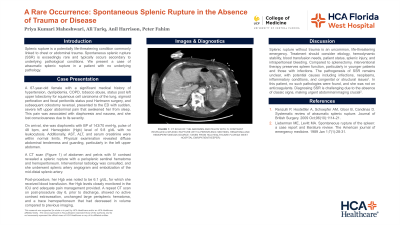Monday Poster Session
Category: IBD
P2732 - A Rare Occurrence: Spontaneous Splenic Rupture in the Absence of Trauma or Disease
Monday, October 28, 2024
10:30 AM - 4:00 PM ET
Location: Exhibit Hall E

Has Audio

Priya Kumari Maheshwari, MD
University of Central Florida, HCA Healthcare GME
Pensacola, FL
Presenting Author(s)
Priya Kumari Maheshwari, MD, Peter Fahim, MD, Ali Tariq, MD, Anil Harrison, MD
University of Central Florida, HCA Healthcare GME, Pensacola, FL
Introduction: Splenic rupture is a potentially life-threatening condition commonly linked to chest or abdominal trauma. Spontaneous splenic rupture (SSR) is exceedingly rare and typically occurs secondary to underlying pathological conditions. We present a case of atraumatic splenic rupture in a patient with no underlying pathology.
Case Description/Methods: A 67-year-old female with a significant medical history of hypertension, dyslipidemia, COPD, tobacco abuse, status post left upper lobectomy for squamous cell carcinoma of the lung, sigmoid perforation and fecal peritonitis status post Hartmann surgery, and subsequent colostomy reversal, presented to the ED with sudden, severe left upper abdominal pain that awakened her from sleep. This pain was associated with diaphoresis and nausea, and she lost consciousness due to its severity.
On arrival, she was diaphoretic with BP of 143/70 mmHg, pulse of 48 bpm, and Hemoglobin (Hgb) level of 9.8 g/dL with no leukocytosis. Additionally, AST, ALT, and serum creatinine were within normal limits. Physical examination revealed diffuse abdominal tenderness and guarding, particularly in the left upper abdomen.
A CT scan of abdomen and pelvis with IV contrast revealed a splenic rupture with a perisplenic sentinel hematoma and hemoperitoneum. Interventional radiology was consulted and she underwent splenic artery angiogram and embolization of the mid-distal splenic artery.
Post-procedure, her Hgb was noted to be 6.1 g/dL, for which she received blood transfusion. Her Hgb levels closely monitored in the ICU and adequate pain management provided. A repeat CT scan on post-procedure day 6, prior to discharge, showed no active contrast extravasation, unchanged large perisplenic hematoma, and a trace hemoperitoneum that had decreased in volume compared to previous imaging.
Discussion: Splenic rupture without trauma is an uncommon, life-threatening emergency. Treatment should consider etiology, hemodynamic stability, blood transfusion needs, patient status, splenic injury, and intraperitoneal bleeding. Compared to splenectomy, interventional therapy preserves spleen function, particularly in younger patients and those with infections. The pathogenesis of SSR remains unclear, with potential causes including infections, neoplasms, inflammatory conditions, and congenital or structural issues. In this patient, no such pathologies were found, and she was not on anticoagulants. Diagnosing SSR is challenging due to the absence of classic signs, making urgent abdominal imaging crucial.

Disclosures:
Priya Kumari Maheshwari, MD, Peter Fahim, MD, Ali Tariq, MD, Anil Harrison, MD. P2732 - A Rare Occurrence: Spontaneous Splenic Rupture in the Absence of Trauma or Disease, ACG 2024 Annual Scientific Meeting Abstracts. Philadelphia, PA: American College of Gastroenterology.
University of Central Florida, HCA Healthcare GME, Pensacola, FL
Introduction: Splenic rupture is a potentially life-threatening condition commonly linked to chest or abdominal trauma. Spontaneous splenic rupture (SSR) is exceedingly rare and typically occurs secondary to underlying pathological conditions. We present a case of atraumatic splenic rupture in a patient with no underlying pathology.
Case Description/Methods: A 67-year-old female with a significant medical history of hypertension, dyslipidemia, COPD, tobacco abuse, status post left upper lobectomy for squamous cell carcinoma of the lung, sigmoid perforation and fecal peritonitis status post Hartmann surgery, and subsequent colostomy reversal, presented to the ED with sudden, severe left upper abdominal pain that awakened her from sleep. This pain was associated with diaphoresis and nausea, and she lost consciousness due to its severity.
On arrival, she was diaphoretic with BP of 143/70 mmHg, pulse of 48 bpm, and Hemoglobin (Hgb) level of 9.8 g/dL with no leukocytosis. Additionally, AST, ALT, and serum creatinine were within normal limits. Physical examination revealed diffuse abdominal tenderness and guarding, particularly in the left upper abdomen.
A CT scan of abdomen and pelvis with IV contrast revealed a splenic rupture with a perisplenic sentinel hematoma and hemoperitoneum. Interventional radiology was consulted and she underwent splenic artery angiogram and embolization of the mid-distal splenic artery.
Post-procedure, her Hgb was noted to be 6.1 g/dL, for which she received blood transfusion. Her Hgb levels closely monitored in the ICU and adequate pain management provided. A repeat CT scan on post-procedure day 6, prior to discharge, showed no active contrast extravasation, unchanged large perisplenic hematoma, and a trace hemoperitoneum that had decreased in volume compared to previous imaging.
Discussion: Splenic rupture without trauma is an uncommon, life-threatening emergency. Treatment should consider etiology, hemodynamic stability, blood transfusion needs, patient status, splenic injury, and intraperitoneal bleeding. Compared to splenectomy, interventional therapy preserves spleen function, particularly in younger patients and those with infections. The pathogenesis of SSR remains unclear, with potential causes including infections, neoplasms, inflammatory conditions, and congenital or structural issues. In this patient, no such pathologies were found, and she was not on anticoagulants. Diagnosing SSR is challenging due to the absence of classic signs, making urgent abdominal imaging crucial.

Figure: Figure: CT Scan of the abdomen and pelvis with IV contrast
Disclosures:
Priya Kumari Maheshwari indicated no relevant financial relationships.
Peter Fahim indicated no relevant financial relationships.
Ali Tariq indicated no relevant financial relationships.
Anil Harrison indicated no relevant financial relationships.
Priya Kumari Maheshwari, MD, Peter Fahim, MD, Ali Tariq, MD, Anil Harrison, MD. P2732 - A Rare Occurrence: Spontaneous Splenic Rupture in the Absence of Trauma or Disease, ACG 2024 Annual Scientific Meeting Abstracts. Philadelphia, PA: American College of Gastroenterology.
